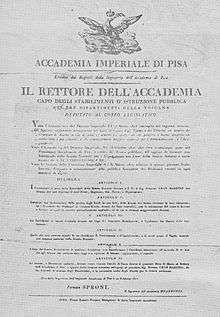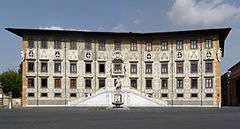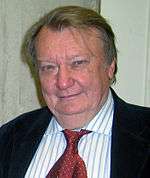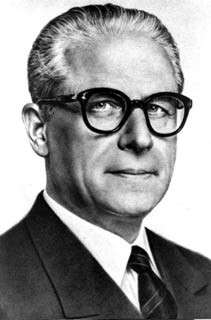Scuola Normale Superiore di Pisa
| Scuola Normale Superiore di Pisa | |
 | |
| Type | State-supported |
|---|---|
| Established | 1810 |
| Director | Prof. Vincenzo Barone |
Administrative staff | ca. 120 |
| Undergraduates | ca. 150 |
| Postgraduates | ca. 120 |
| ca. 190 | |
| Location | Pisa, Italy |
| Website | www.sns.it/ |
The Scuola Normale Superiore di Pisa (SNS) is a public higher learning institution in Pisa, Italy.
The Scuola Normale, together with the University of Pisa and Sant'Anna School of Advanced Studies, is a part of the Pisa University System. It is one of the three officially sanctioned special-statute public universities in Italy, being part of the process of Superior Graduate School in Italy (grandes écoles),[1] or Scuola Superiore Universitaria.[2]
According to the World University Ranking 2016 made by the Times, Normale is considered to be the best university in Italy and one among the best 50 in Europe.[3]
History
The Scuola Normale Superiore was founded in 1810 by Napoleonic decree, as twin institution of the École Normale Supérieure in Paris, itself dating back to the French Revolution jurisdiction.
The term école normale (scuola normale) was coined by Joseph Lakanal who, in submitting a report to the National Convention of 1794 on behalf of the Committee of Public Instruction, explained it as follows: "Normales : du latin norma, règle. Ces écoles doivent être en effet le type et la règle de toutes les autres." [4][5]
The Decree of Foundation
Napoleon I rethought the project of an école normale in 1808, by establishing a hall of residence in Paris to house young students and train them in the art of teaching the humanities and sciences. The project was replicated in Tuscany by a decree dated 18 October 1810, with the foundation in Pisa, seat of one of the Imperial University Academies, of a branch of the École Normale Supérieure of Paris, called the Scuola Normale Superiore.[4][6]
The Grand-Duchy Period: 1847–1859

When, in 1814, Ferdinand III, Grand Duke of Tuscany returned to Tuscany, the project of a Scuola Normale in Pisa ceased. Only at the beginning of the 1840s, in connection with the university reform of 1839-1841, was the project resumed. The question was combined with the proposals of resumption of the educational activities of the ancient Order of Saint Stephen, whose main premises were within the Palazzo della Carovana in Pisa. On 28 November 1846, a grand-ducal motu proprio founded a Tuscan Scuola Normale in Pisa (also referred to as the Imperial Royal Scuola Normale, since it was linked to the Austrian system), with both theoretical and practical aims, under the patronage of the Order of Saint Stephen, but depending on the University of Pisa.[4][7]
The Scuola Normale during the Kingdom of Italy: 1859-1862
On 17 October 1862 the Minister of Education of the Kingdom of Italy Carlo Matteucci implemented new regulations in a decree that transformed the institution to the famous Normal School of the Kingdom of Italy. There was to be an organic division into two Faculties, of Arts and Sciences.[4][7]
Scuola Normale from 1863–1927
In 1863, was appointed a new Director of the Scuola Normale, the respected Pasquale Villari. Villari left the Scuola in 1865, and his place was taken by the mathematician Enrico Betti; from 1890 to 1900, the position of Director was filled by literature historian Alessandro d'Ancona, and from 1900 to 1918 by the mathematician Ulisse Dini. The new regulations, issued by Minister Michele Coppino in 1877, reviewed and simplified the internal study regulations and equalized, from an organizational point of view.[4][7]
The Scuola Normale under Gentile: 1928–1943
The philosopher Giovanni Gentile was placed at the head of the Scuola Normale as commissioner in 1928 and as director in 1932. He expended the premises of the Scuola Normale, Palazzo dei Cavalieri, and also promulgated a new statute in 1932, which recognized the Scuola Normale as an advanced education institute with "a legal status and administrative, educational and disciplinary autonomy", insuring autonomy from the University of Pisa. Further, he reformed the Scuola, gave it formal autonomy and sought an expansion to other disciplines, with the creation of the Collegio Mussolini per le Scienze Corporative (1931) and the Collegio Nazionale Medico (1932). The new colleges were later merged in the Collegio Medico-Giuridico,[8] which continued to operate (in the fields of law and medicine) under the jurisdiction of the Scuola Normale Superiore di Pisa.[6][7][9][10][11][12]
Post-war Period
During the post-war period, there were many practical difficulties; however, besides the restoration of Palazzo dei Cavalieri. Scuola Normale in 1951, established the Antonio Pacinotti boarding school, reserved to students of the faculties of Agriculture, Economics and Engineering, with plans to be further opened to other faculties as well. In 1967 the Scuola Superiore di Studi Universitari e Perfezionamento merged the Scuola per le Scienze Applicate A. Pacinotti (founded in 1951) and the Collegio Medico-Giuridico forming the Sant'Anna School of Advanced Studies. The new institution, while still committed to the model established by the Scuola Normale Superiore di Pisa, was administered by the University of Pisa. In 1987 Sant'Anna School of Advanced Studies acquired complete independence (Law of 14 February 1987, No.41)[13][14] and maintains strong ties with both the Scuola Normale Superiore di Pisa and the University of Pisa creating the Pisa University System.[6][7][9][10][11][12]
The present-day structure
Over time, the Scuola Normale has increasingly opened up to society, and while remaining an elite institute, has offered its cultural activities and heritage to an ever-wider audience. Also, thanks to the law of 18 June 1986, which granted the Diploma di Perfezionamento equivalent to Doctor of Philosophy,[15][16] the Scuola Normale has been given separate university status by the Ministry of Education, Universities and Research, together with Sant'Anna School of Advanced Studies leading the model of Scuole di Eccellenza (Schools of Excellence or Superior Graduate Schools in Italy)[1][17] or Scuola Superiore Universitaria.[2]
Organisation
The educational programs at the Scuola Normale are divided into two levels: Undergraduate and Doctoral. The undergraduate program corresponds to the 1st-cycle (Bachelor) and 2nd-cycle (Postgraduate) programs provided by Italian universities.
In 1927, in addition to the undergraduate program, the Scuola Normale was the first institution in Italy to create a doctoral program (PhD) (Italian: Corsi di Perfezionamento),[15] equivalent to the PhD introduced in other Italian universities in 1980, 3rd cycle degrees as predicted by the Bologna Process. Moreover, every year the Scuola Normale announces competitions for post-doctoral grants: the grantee works in close contact with the best Italian and foreign professors within the laboratories and research centers of the Scuola Normale and has the opportunity to collaborate with the most important and prestigious institutions, both Italian and international.
Campus

.jpg)
The Scuola Normale is located in its original historical building, called Palazzo della Carovana, in Piazza dei Cavalieri, in the medieval centre of Pisa.
Academics
Fields of study
The Scuola Normale offers classes in both humanities and sciences.
Faculty of Arts
The Faculty of Arts is organized into five disciplinary areas:
- Ancient History and Classical Philology
- Italian Literature and Linguistics
- Art History and Archaeology
- History and Paleography
- Philosophy
Faculty of Sciences
The Faculty of Sciences is organized into five disciplinary areas:
Admission
In order to become a student at the Scuola Normale, or normalista, the candidate must pass an extremely selective admissions exam. There are only sixty candidates admitted out of nearly 1000 applicants on average every year, which is only 6% admission rate. The exam comprises questions covering the entire chosen field of study. The normalisti receive free housing, free lunches and dinners, and a monthly stipend.
Students live in colleges: Collegio Domenico Timpano, Collegio Alessandro d'Ancona, Collegio Enrico Fermi, Collegio Giosue Carducci and Collegio Alessandro Faedo (together with the Honours College Students (allievi) of Sant'Anna School of Advanced Studies)[11]
The Scuola does not have a full programme of undergraduate and graduate studies; instead, the students follow the ordinary courses at the public University of Pisa, and complement them with additional classes and seminars taught by the professors of the Scuola Normale. The normalisti are required to score high marks in their exams at the public university (average marks of at least 27/30 and no mark below 24/30) in order to maintain their scholarship. The PhD programme, instead, is separate and completely independent of the degrees at the University of Pisa. The PhD course is called corso di perfezionamento, and the students are called perfezionandi. The perfezionamento, instituted in 1927, is much older than the PhD programme of the Italian public university, instituted in 1980.
Undergraduate Programmes
Undergraduate programs at the Scuola Normale correspond to the 1st-cycle (Bachelor) and 2nd-cycle (Master) programmes provided by the Italian university system (a three-plus-two year program). In order to pursue undergraduate work at the Scuola, students must pass competitive entrance exams. Students who are admitted from the first year of the Scuola Normale are entitled to continue for the full five years, on condition that they fulfill their yearly academic obligations. Every student of the Scuola Normale must enroll in a degree programme at the University of Pisa, and their degree programme must correspond to the educational areas of the Scuola Normale in the Faculty of Arts and the Faculty of Sciences. If they fulfill their academic obligations, the students receive the Bachelor's degree from the University of Pisa and the first-level diploma from the Scuola Normale at the end of their third year, and the postgraduate degree from the University of Pisa and the second-level diploma from the Scuola Normale at the end of their fifth year.
According to Scuola Normale regulations, in order to be admitted to the next academic year and remain a student of the Scuola Normale, undergraduate students must maintain annual average marks of at least 27/30, and no single mark lower than 24/30 for the studies carried out at the University of Pisa.[4]
The undergraduate programs offered are:[18]
- Bachelor Programmes – Faculty of Arts : Literature, Humanities Computing, Cinema, Music and Theater, Philosophy, History, Cultural Heritage Sciences
- Bachelor Programmes – Faculty of Sciences: Chemistry, Physics, Computer Science, Mathematics, Biology and Molecular Biology, Ecology and Biodiversity, Geology, Natural Sciences, Chemical Sciences and Technologies for Industry and the Environment
Postgraduate Programmes
The postgraduate programmes offered are:[19]
- Postgraduate Programmes – Faculty of Arts
- Italian Language and Literature
- European Literature and Philology
- Linguistics
- Cinema, Theater and Multimedia Production
- Geography
- Philosophy and Forms of Knowledge
- Archaeology
- Art History
- Near Eastern and Middle Eastern Languages and Civilizations
- Classical Studies
- Library and Archival Sciences
- History and Civilization
- Postgraduate Programmes – Faculty of Sciences
- Marine Biology
- Chemistry
- Industrial Chemistry
- Applied Physics
- Natural Resource Management
- Computer Science
- Mathematics
- Neurobiology
- Materials Science
- Environmental Science and Technologies
- Biomolecular Science and Technologies
- Physical Science
- Physiopathology
- Geology
- Information technology
Doctoral Programmes (PhD)
Scuola Normale Superiore di Pisa was the first institution in Italy, in 1927, to create a doctoral programme, under the original name Diploma di Perfezionamento.[4][20] Research doctorates (Italian: Dottorato di ricerca) in Italy were later introduced in 1980.[21][22][23]
The Superior Graduate Schools in Italy (grandes écoles)[1] (Italian: Scuola Superiore Universitaria),[24] also called Schools of Excellence (Scuole di Eccellenza)[1][25] such as Scuola Normale and Sant'Anna School of Advanced Studies still keep their reputed historical "Diploma di Perfezionamento" title.[15][20][26][27][28]
The Doctoral Programmes offered by Scuola Normale Superiore grant a degree fully equivalent to a Ph.D. and are recognized International Doctoral Programmes involving various forms of collaboration and joint ventures with foreign universities.[16]
Exchange agreements
Undergraduate and doctoral students of the Scuola Normale can participate in exchange fellowship programs and spend study periods abroad based on specific framework conventions between the Scuola Normale and several international universities like University of California - Los Angeles, New York University, Oxford University, Ecole Normale Superieure.[29]
Post-doctoral continuing education and research
The Scuola Normale is part of a highly qualified university and research institution network. In addition to the University of Pisa and the Sant'Anna School of Advanced Studies, the Scuola Normale actively collaborates with the National Research Council (Consiglio Nazionale delle Ricerche, CNR), whose largest research center is located in Pisa.
An extremely significant aspect of the Scuola Normale is the intertwining of education and research, which is a peculiar feature of both undergraduate and doctoral programs.[30][31]
Library
The Library was founded along with the Scuola Normale and has gradually expanded to a size of more than 800,000 volumes and 4,000 periodicals, while always guaranteeing open access. Today it is the largest open-shelf library in Italy and one of the largest in Europe and in the world.
It is housed in three buildings: Palazzo della Carovana, where the periodical section is located, Palazzo della Gherardesca, currently housing most of the volumes, and Palazzo del Capitano, housing the whole section of Sciences (volumes and periodicals), the sector of Art and the sector of Antique and Rare Works.[32]
Rankings
| University rankings | |
|---|---|
| Global | |
| ARWU[33] | 401-500 |
| Times[34] | 112 |
| Europe | |
| ARWU[35] | 100-150 |
| Times[36] | 50 |
- The Academic Ranking of World Universities puts this system at the first place in Italy (National Rank # 1) and within the best 30 universities in Europe.[37]
- Sant'Anna School of Advanced Studies, together with Scuola Normale Superiore are named as leading institutions in Italy's six top higher education institutes by Times Higher Education World University Rankings,[2] where for 2014-2015 was ranked at 63rd place in the world and 15th in Europe.[38] As for 2015-16 rankings, Times Higher Education World University Rankings puts Sant'Anna School of Advanced Studies at 180th place in the world and 2nd in Italy, and Scuola Normale Superiore 112 place in the world and 1st in Italy.[39][40] According to Times Higher Education World University Rankings, Sant'Anna School of Advanced Studies is in top 20% in teaching, industry income and citations in the world, and Scuola Normale Superiore is in top 10% in teaching and top 20% in research on global level.[39][40]
- According to QS World University Rankings, Sant'Anna School of Advanced Studies and Scuola Normale Superiore are part of the initiative "Invest Your Talent in Italy"[41] which puts Italian graduate programmes on the world's stage.[42]
- The European Research Ranking,[43] a ranking based on publicly available data from the European Commission database puts Pisa University System among the best in Italy and best performing European research institutions.[44]
Notable alumni and faculty




Notable alumni and faculty of the Scuola Normale include:[45][46]
- Aldo Andreotti, mathematician, noted for his fundamental contributions to the theory of functions of several complex variables
- Giuliano Amato, politician and former Prime Minister of Italy, also studied at the Collegio Medico-Giuridico of the Scuola Normale Superiore, which today is Sant'Anna School of Advanced Studies
- Luigi Bianchi, mathematician, a leading member of the vigorous geometric school which flourished in Italy during the later years of the 19th century and the early years of the 20th century
- Giosuè Carducci, poet, 1906 Nobel Prize in Literature
- Antonio Cassese, jurist who specialized in public international law, President of the Special Tribunal for Lebanon, also studied at the Collegio Medico-Giuridico of the Scuola Normale Superiore, which today is Sant'Anna School of Advanced Studies
- Sabino Cassese, Professor of Administrative Law and a judge of the Constitutional Court of Italy, also studied at the Collegio Medico-Giuridico of the Scuola Normale Superiore, which today is Sant'Anna School of Advanced Studies
- Lamberto Cesari, mathematician, remembered for his achievements on the Plateau's problem, on the theory of parametric minimal surfaces, on Lebesgue measure of continuous and related other variational problems: he also worked in the field of optimal control and studied periodic solutions of systems of nonlinear ordinary differential equations by using methods of nonlinear functional analysis
- Carlo Azeglio Ciampi, Prime Minister of Italy from 1993 to 1994 and tenth President of the Italian Republic from 1999 to 2006. Until his death, he served as Senator for life in the Italian Senate
- Pietro Citati, writer[47] and literary critic.
- Ennio De Giorgi, mathematician who worked on partial differential equations and the foundations of mathematics, solved the 19th Hilbert problem, won Wolf Prize in 1990
- Enrico Fermi, physicist, 1938 Nobel Prize in Physics for his work on induced radioactivity, particularly known for his work on the development of the first nuclear reactor, Chicago Pile-1, and for his contributions to the development of quantum theory, nuclear and particle physics, and statistical mechanics. Fermi is widely regarded as one of the leading scientists of the 20th century, highly accomplished in both theory and experiment.[48] Along with J. Robert Oppenheimer,[49] he is frequently referred to as "the father of the atomic bomb".[50][51]
- Guido Fubini, mathematician, known for Fubini's theorem and the Fubini–Study metric
- Giovanni Gentile, Minister of Public Education (1923) and neo-Hegelian Idealist philosopher, a peer of Benedetto Croce, described himself as 'the philosopher of Fascism', and ghostwrote A Doctrine of Fascism (1932) for Benito Mussolini, also devised his own system of philosophy, Actual Idealism, and Professor at the Scuola Normale Superiore
- Carlo Ginzburg, noted historian and proponent of the field of microhistory. He is best known for his Il formaggio e I vermi (1976, English title: The Cheese and the Worms: The Cosmos of a Sixteenth Century Miller) which examined the beliefs of an Italian heretic, Menocchio, from Montereale Valcellina
- Giovanni Gronchi, politician, President of Italy from 1955 to 1962
- Eugenio Elia Levi, mathematician, noted for his fundamental contributions to group theory, the theory of partial differential equations and theory of functions of several complex variables
- Salvatore Settis, archeologist, former director of the Getty Center for the History of Art and the Humanities and also of the Scuola Normale itself, now President of the Scientif Committee of the Musée du Louvre
- Carlo Rubbia, Knight Grand Cross particle physicist and inventor who shared the Nobel Prize in Physics in 1984 with Simon van der Meer for work leading to the discovery of the W and Z particles at CERN
- Leonida Tonelli, mathematician, most noted for creating Tonelli's theorem, usually considered a forerunner to Fubini's theorem.[52]
- Vito Volterra, mathematician and physicist, known for his contributions to mathematical biology and integral equations.[53][54]
- Jiyuan Yu, moral philosopher noted for his work on virtue ethics
See also
- Sant'Anna School of Advanced Studies
- Pisa University System
- University of Pisa
- List of Italian universities
- École Normale Supérieure
- Pisa
References
- 1 2 3 4 "ResearchItaly - Pagina di transizione". Retrieved 27 July 2015.
- 1 2 3 "Italy's big six form network for elite". Times Higher Education. 18 February 2000. Retrieved 5 November 2011.
- ↑ http://24o.it/links/?uri=https://www.timeshighereducation.com/world-university-rankings/best-universities-in-europe-2016&from=Ranking+del+Times%3A+Normale+e+Sant%27Anna+di+Pisa+tra+le+100+migliori+universit%C3%A0+d%27Europa+
- 1 2 3 4 5 6 7 Student Guidebook - Scuola Normale Superiore di Pisa
- ↑ Cécile Le Jeune. "ENS Rennes - ENS Rennes - Accueil". Retrieved 27 July 2015.
- 1 2 3 Nicola Bellini, Nadio Delai (a cura di), Merito, Ambizione, Collegialità: il contributo della Scuola Superiore Sant'Anna alla formazione della classe dirigente, ETS, Pisa, 2009
- 1 2 3 4 5 Nicola Bellini, Nadio Delai (a cura di), Merito, Ambizione, Collegialità: il contributo della Scuola Superiore Sant'Anna alla formazione della classe dirigente, ETS, Pisa, 2009
- ↑ Michele Fiaschi, Andrea Freccioni (Servizio Comunicazione Integrata Scuola Normale). "Scuola Normale Superiore di Pisa 1810-2010 - La Normale nella Repubblica". Retrieved 27 July 2015.
- 1 2 Gianluca Breghi, Elisa Neri (a cura di), La chiesa e il monastero di Sant'Anna in Pisa: sede della Scuola Superiore Sant'Anna, Bandecchi & Vivaldi, Pontedera, 2002
- 1 2 Silvia Alessi, L'educazione del cuore e la formazione del carattere: vita collegiale della giovine al Conservatorio di Sant'Anna in Pisa. 1860-1920, ETS, Pisa, 2006
- 1 2 3 Guide for International Students, Scuola Superiore Sant’Anna, II Edition, 2011
- 1 2 "Felici Editore". Retrieved 27 July 2015.
- ↑ Law of 14 February 1987, No.41 | L. 14 febbraio 1987, n. 41 Istituzione della Scuola superiore di studi universitari e di perfezionamento S. Anna di Pisa
- ↑ Università in Italia, Ministry of Education, Universities and Research (MIUR)
- 1 2 3 Ministry of Education, Universities and Research (MIUR) Decree
- 1 2 "404 - Pagina non trovata - Scuola Normale Superiore" (PDF). Retrieved 27 July 2015.
- ↑ Superior Graduate School in Italy (grandes écoles)
- ↑ "Undergraduate Admission - Scuola Normale Superiore". Retrieved 27 July 2015.
- ↑ Scuola normale superiore di Pisa Admission
- 1 2 "404 - Pagina non trovata - Scuola Normale Superiore" (PDF). Retrieved 27 July 2015.
- ↑ Law of 21 February 1980, No. 28 and Presidential Decree No. 382 of 11 July 1980
- ↑ Law of 21 February 1980, No. 28
- ↑ "Decreto Presidente Repubblica 11 luglio 1980, n. 382". Retrieved 27 July 2015.
- ↑ "Italy's big six form network for elite". Times Higher Education. Retrieved 27 July 2015.
- ↑ "Scuole - Scuole di Eccellenza". Retrieved 27 July 2015.
- ↑ Article 3 of the Law of 14 February 1987, No.41 | L. 14 febbraio 1987, n. 41 Istituzione della Scuola superiore di studi universitari e di perfezionamento S. Anna di Pisa
- ↑ MIUR Decree
- ↑ Università in Italia, Ministry of Education, Universities and Research (MIUR)
- ↑ "SNS: Formazione e Ricerca, progresso e tradizione - Scuola Normale Superiore". Retrieved 27 July 2015.
- ↑ "Humanities - Scuola Normale Superiore". Retrieved 27 July 2015.
- ↑ "Mathematical and Natural Sciences - Scuola Normale Superiore". Retrieved 27 July 2015.
- ↑ Scuola Normale Superiore di Pisa Library
- ↑ "Academic Ranking of World Universities: Global". Institute of Higher Education, Shanghai Jiao Tong University. 2016. Retrieved September 8, 2016.
- ↑ "World University Rankings 2016-2017". Times Higher Education. 2015. Retrieved October 22, 2016.
- ↑ "Academic Ranking of World Universities: Global". Institute of Higher Education, Shanghai Jiao Tong University. 2016. Retrieved September 8, 2016.
- ↑ "Best universities in Europe 2017". The Times Higher Education. 2016. Retrieved October 22, 2016.
- ↑ "Academic Ranking of World Universities | ARWU | First World University Ranking | Shanghai Ranking". ARWU. Retrieved 5 November 2011.
- ↑ "Times Higher Education World University Rankings 2014-2015". Times Higher Education World University Rankings. Retrieved 15 May 2015.
- 1 2 Times Higher Education World University Rankings 2015-2016 / Scuola Superiore Sant’Anna
- 1 2 Times Higher Education World University Rankings 2015-2016 / Scuola Normale Superiore di Pisa
- ↑
- ↑ "Italian graduate programmes on the world's stage | Topgradschool". Graduateschool.topuniversities.com. Retrieved 5 November 2011.
- ↑ "ResearchRanking.org: European Research Ranking - home". Retrieved 27 July 2015.
- ↑ "European Research Ranking 2010". Researchranking.org. Retrieved 5 November 2011.
- ↑ "Scuola Normale Superiore di Pisa, anno accademico 2009/2010". Retrieved 27 July 2015.
- ↑ "Quale futuro per la Normale di Pisa". Retrieved 27 July 2015.
- ↑ Alfieri, Maria Chiara (27 March 2011). ""Leopardi" di Pietro Citati". NonSoloCinema (in Italian). Retrieved 19 June 2011.
- ↑ Snow, C. (1981). The Physicists: A Generation that Changed the World. Little Brown. ISBN 1-84232-436-5.
- ↑ Goodchild, P. (1983). Oppenheimer: The Father of the Atom Bomb. BBC. ISBN 0-563-20212-2.
- ↑ "Enrico Fermi Dead at 53; Architect of Atomic Bomb". The New York Times. 23 November 1954. Retrieved 2010-08-08.
- ↑ Lichello, R. (1971). Enrico Fermi: Father of the Atomic Bomb. SamHar Press. ISBN 978-0-87157-011-6.
- ↑ Leonida Tonelli.
- ↑ O'Connor, John J.; Robertson, Edmund F., "Scuola Normale Superiore di Pisa", MacTutor History of Mathematics archive, University of St Andrews.
- ↑ Scuola Normale Superiore di Pisa at the Mathematics Genealogy Project
External links
| Wikimedia Commons has media related to Scuola Normale Superiore (Pisa). |
- Official website (Italian) (English)
Coordinates: 43°43′10.60″N 10°24′0.81″E / 43.7196111°N 10.4002250°E